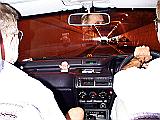 The saying, "What a way to start the day," is often
overused in today's world. However, I can think of no better way to
describe how our morning began than by using that time honored
expression. Within minutes of arriving at the NIWA laboratories,
Clyde's ever present
cellular telephone
rang and it was Steve O'Shea at
the other end of the line telling Clyde that yet another giant squid
had been captured in one of the deep water fishing trawls and that we
should rush down to the National Museum to pick it up. In what seemed
like only seconds, Clyde, Steve and I were hurtling through the streets
of downtown Wellington on our way to the Museum. One of the more
interesting customs that I have come to observe here in Wellington is
the behavior of drivers as they make their way through the Victoria
tunnel. Many years ago, some civil engineer must have decided that it
was going to be easier to bore an enormous hole directly through one of
the hills in Wellington and run a road through it, rather than to try
and figure out a way to make the road go over it. When Steve first
drove me through the tunnel, as soon as we entered it, he tooted the
car's horn. To my mind, I figured that he was just trying to impress
me with the acoustics of the tunnel. And to be quite honest, I was
very impressed because for quite some time, I heard what sounded like
echoes of our horn in the distance. But then Steve did it again and
this time, the echo was actually louder than the original. Now I may
not be an acoustical engineer, but I do know that echoes are usually
never as loud as the original. It turns out, as Steve so happily
explained, that there is a tradition of honking one's horn at other
cars going through the tunnel and they honk theirs in return. To my
untrained ears, it sounded more like a flock of Canadian Geese flying
overhead than cars saying hello to each other, but who was I to judge
another country's customs?
The saying, "What a way to start the day," is often
overused in today's world. However, I can think of no better way to
describe how our morning began than by using that time honored
expression. Within minutes of arriving at the NIWA laboratories,
Clyde's ever present
cellular telephone
rang and it was Steve O'Shea at
the other end of the line telling Clyde that yet another giant squid
had been captured in one of the deep water fishing trawls and that we
should rush down to the National Museum to pick it up. In what seemed
like only seconds, Clyde, Steve and I were hurtling through the streets
of downtown Wellington on our way to the Museum. One of the more
interesting customs that I have come to observe here in Wellington is
the behavior of drivers as they make their way through the Victoria
tunnel. Many years ago, some civil engineer must have decided that it
was going to be easier to bore an enormous hole directly through one of
the hills in Wellington and run a road through it, rather than to try
and figure out a way to make the road go over it. When Steve first
drove me through the tunnel, as soon as we entered it, he tooted the
car's horn. To my mind, I figured that he was just trying to impress
me with the acoustics of the tunnel. And to be quite honest, I was
very impressed because for quite some time, I heard what sounded like
echoes of our horn in the distance. But then Steve did it again and
this time, the echo was actually louder than the original. Now I may
not be an acoustical engineer, but I do know that echoes are usually
never as loud as the original. It turns out, as Steve so happily
explained, that there is a tradition of honking one's horn at other
cars going through the tunnel and they honk theirs in return. To my
untrained ears, it sounded more like a flock of Canadian Geese flying
overhead than cars saying hello to each other, but who was I to judge
another country's customs?
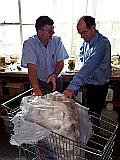 We soon reached the National Museum and made our way up the freight
elevator to Bruce Marshall's office where there, propped up in a
shopping cart was about a 30 kilogram frozen block that was the remains
of yet another giant squid from New Zealand Waters. By Steve's count,
that makes four Architeuthis specimens that have been found in just
this year alone. Clyde and Bruce talked for a while about things with
We soon reached the National Museum and made our way up the freight
elevator to Bruce Marshall's office where there, propped up in a
shopping cart was about a 30 kilogram frozen block that was the remains
of yet another giant squid from New Zealand Waters. By Steve's count,
that makes four Architeuthis specimens that have been found in just
this year alone. Clyde and Bruce talked for a while about things with
 names that had absolutely no meaning to me and then they went off into
one of the labs and Clyde started poking around with what looked like a
pair of chopsticks in a tray of little, preserved creatures including a
very cute (well, beauty IS in the eye of the beholder) octopus that was
no more than four inches long. Clyde was beside himself with joy as he
wheeled the cart into the freight elevator for the trip back to NIWA.
As we emerged from the Victoria tunnel again, I got to thinking about
the fact that here we were, driving through the streets of downtown
Wellington with one of the most elusive creatures on the face of the
earth, slowly defrosting the in boot (trunk) of Steve's white Toyota
Corolla. To use Clyde's words, "it certainly seems like Kaikoura
is the place to be!"
names that had absolutely no meaning to me and then they went off into
one of the labs and Clyde started poking around with what looked like a
pair of chopsticks in a tray of little, preserved creatures including a
very cute (well, beauty IS in the eye of the beholder) octopus that was
no more than four inches long. Clyde was beside himself with joy as he
wheeled the cart into the freight elevator for the trip back to NIWA.
As we emerged from the Victoria tunnel again, I got to thinking about
the fact that here we were, driving through the streets of downtown
Wellington with one of the most elusive creatures on the face of the
earth, slowly defrosting the in boot (trunk) of Steve's white Toyota
Corolla. To use Clyde's words, "it certainly seems like Kaikoura
is the place to be!"
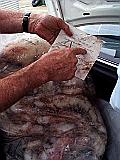
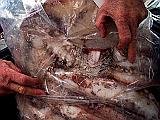 When we got back to the lab, Clyde and Steve carefully opened the
plastic bag that the squid was wrapped in and pulled out the tag that
the observer had written which described where (approximately 440 meters)
When we got back to the lab, Clyde and Steve carefully opened the
plastic bag that the squid was wrapped in and pulled out the tag that
the observer had written which described where (approximately 440 meters)
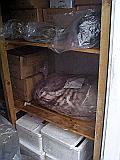 and when (February 12, 1999) the squid was caught. Covering the
outside of the squid were small, white, threadlike strands. Clyde told
me that these were the squid's spermatophores and that in all
likelihood, this squid was a small male. At just that moment, one of
the NIWA scientists who had been here the other night to help carry the
other squid from the dissection room into the formalin tank happened to
walk by and I called out "this is your lucky day." The two
of us lifted the squid out of the car and carefully placed it on a
shelf in the large, walk-in freezer. Walking back to the Lab
afterwards, I noticed that yet again, I had managed to cover myself
with that distinctive, yet very rare odor of giant squid.
and when (February 12, 1999) the squid was caught. Covering the
outside of the squid were small, white, threadlike strands. Clyde told
me that these were the squid's spermatophores and that in all
likelihood, this squid was a small male. At just that moment, one of
the NIWA scientists who had been here the other night to help carry the
other squid from the dissection room into the formalin tank happened to
walk by and I called out "this is your lucky day." The two
of us lifted the squid out of the car and carefully placed it on a
shelf in the large, walk-in freezer. Walking back to the Lab
afterwards, I noticed that yet again, I had managed to cover myself
with that distinctive, yet very rare odor of giant squid.
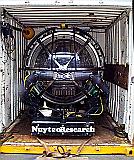
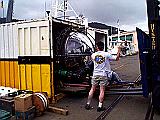
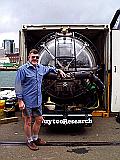 Having just enough time to wash off (although the scent of giant squid
is something that seems to linger no matter how hard or how long you
wash), Clyde and I rushed down to King's Wharf to watch the Kaharoa's
crew prepare to hoist Deep Rover from the dock onto the ship. The
first thing that needed to be done was to pull Deep Rover far enough
out of its shipping container so that the hoisting strap on the top on
the sub could be grabbed by the crane. Using a forklift and great
care, the forklift operator under the direction of the Nuytco crew
gentle maneuvered the sub halfway out of the container. It was at this
time that Clyde had his first real chance to
"kick the tires."
He walked around the sub, peering through the 5 inch
thick acrylic sphere to the
pilot's seat and where, attached right
next to it, was a little gauge with the name
"lev-o-gage"
printed on it. I can only imagine what it must feel like when the
gauge is reading its maximum, 45 degrees off horizontal. This was also
the first time that
I got to see Deep Rover.
It is certainly a
marvelous little machine....with the emphasis on the word
"little".
Having just enough time to wash off (although the scent of giant squid
is something that seems to linger no matter how hard or how long you
wash), Clyde and I rushed down to King's Wharf to watch the Kaharoa's
crew prepare to hoist Deep Rover from the dock onto the ship. The
first thing that needed to be done was to pull Deep Rover far enough
out of its shipping container so that the hoisting strap on the top on
the sub could be grabbed by the crane. Using a forklift and great
care, the forklift operator under the direction of the Nuytco crew
gentle maneuvered the sub halfway out of the container. It was at this
time that Clyde had his first real chance to
"kick the tires."
He walked around the sub, peering through the 5 inch
thick acrylic sphere to the
pilot's seat and where, attached right
next to it, was a little gauge with the name
"lev-o-gage"
printed on it. I can only imagine what it must feel like when the
gauge is reading its maximum, 45 degrees off horizontal. This was also
the first time that
I got to see Deep Rover.
It is certainly a
marvelous little machine....with the emphasis on the word
"little".
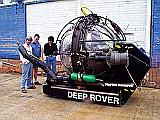
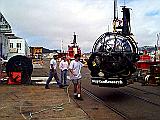 Without too much effort, the large
shipping container
which contains
all the gear, parts and support equipment for the sub was hoisted off
the dock and lowered onto the deck of the Kaharoa, in the place that
was cleared for it the day before. For several hours, the Nuytco crew
Without too much effort, the large
shipping container
which contains
all the gear, parts and support equipment for the sub was hoisted off
the dock and lowered onto the deck of the Kaharoa, in the place that
was cleared for it the day before. For several hours, the Nuytco crew
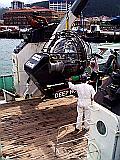 carefully checked the sub over, and started familiarizing Mike and
Clyde, the two members of the expedition who will be piloting Deep
Rover, with some of its features. To open the two halves of the
sphere, Ian inserted a large,
hand-held crank
into a screw just beneath
the sphere and started turning it. I couldn't help thinking that it
looked like an old comedy movie where the way to start a car was to put
a crank into the engine and turn like mad. As Ian turned the crank,
the sphere slowly started to move apart at the bottom until the gap was
wide enough for one person to be able to crawl through - with shoes off
and socks on. Both Mike and Clyde had a chance to get into the sub
and see what it felt like to sit in the pilot's seat and put their
hands on the control grips. After a while, it was time for the
crane
to hoist Deep Rover and with ever so much care, swing it across the
dock and
lower it gently
to the fantail....right beneath the Kaharoa's
massive A-frame gantry.
carefully checked the sub over, and started familiarizing Mike and
Clyde, the two members of the expedition who will be piloting Deep
Rover, with some of its features. To open the two halves of the
sphere, Ian inserted a large,
hand-held crank
into a screw just beneath
the sphere and started turning it. I couldn't help thinking that it
looked like an old comedy movie where the way to start a car was to put
a crank into the engine and turn like mad. As Ian turned the crank,
the sphere slowly started to move apart at the bottom until the gap was
wide enough for one person to be able to crawl through - with shoes off
and socks on. Both Mike and Clyde had a chance to get into the sub
and see what it felt like to sit in the pilot's seat and put their
hands on the control grips. After a while, it was time for the
crane
to hoist Deep Rover and with ever so much care, swing it across the
dock and
lower it gently
to the fantail....right beneath the Kaharoa's
massive A-frame gantry.
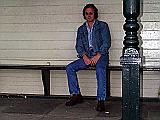 Later that evening after all the "work" was done and I had
managed to warm up after spending most of the day standing on a very
cold, windswept dock, I took a walk into Wellington and sat along the
bayfront promenade. Each day I am amazed at the beauty of Wellington
and the friendliness of every single person that I had a chance to
meet. New Zealanders seem to be very proud of their city and I for one
can understand that completely.
Later that evening after all the "work" was done and I had
managed to warm up after spending most of the day standing on a very
cold, windswept dock, I took a walk into Wellington and sat along the
bayfront promenade. Each day I am amazed at the beauty of Wellington
and the friendliness of every single person that I had a chance to
meet. New Zealanders seem to be very proud of their city and I for one
can understand that completely.
regards,
gene
 We soon reached the National Museum and made our way up the freight
elevator to Bruce Marshall's office where there, propped up in a
shopping cart was about a 30 kilogram frozen block that was the remains
of yet another giant squid from New Zealand Waters. By Steve's count,
that makes four Architeuthis specimens that have been found in just
this year alone. Clyde and Bruce talked for a while about things with
We soon reached the National Museum and made our way up the freight
elevator to Bruce Marshall's office where there, propped up in a
shopping cart was about a 30 kilogram frozen block that was the remains
of yet another giant squid from New Zealand Waters. By Steve's count,
that makes four Architeuthis specimens that have been found in just
this year alone. Clyde and Bruce talked for a while about things with
 names that had absolutely no meaning to me and then they went off into
one of the labs and Clyde started poking around with what looked like a
pair of chopsticks in a tray of little, preserved creatures including a
very cute (well, beauty IS in the eye of the beholder) octopus that was
no more than four inches long. Clyde was beside himself with joy as he
wheeled the cart into the freight elevator for the trip back to NIWA.
As we emerged from the Victoria tunnel again, I got to thinking about
the fact that here we were, driving through the streets of downtown
Wellington with one of the most elusive creatures on the face of the
earth, slowly defrosting the in boot (trunk) of Steve's white Toyota
Corolla. To use Clyde's words, "it certainly seems like Kaikoura
is the place to be!"
names that had absolutely no meaning to me and then they went off into
one of the labs and Clyde started poking around with what looked like a
pair of chopsticks in a tray of little, preserved creatures including a
very cute (well, beauty IS in the eye of the beholder) octopus that was
no more than four inches long. Clyde was beside himself with joy as he
wheeled the cart into the freight elevator for the trip back to NIWA.
As we emerged from the Victoria tunnel again, I got to thinking about
the fact that here we were, driving through the streets of downtown
Wellington with one of the most elusive creatures on the face of the
earth, slowly defrosting the in boot (trunk) of Steve's white Toyota
Corolla. To use Clyde's words, "it certainly seems like Kaikoura
is the place to be!"
 The saying, "What a way to start the day," is often
overused in today's world. However, I can think of no better way to
describe how our morning began than by using that time honored
expression. Within minutes of arriving at the NIWA laboratories,
Clyde's ever present
cellular telephone
rang and it was Steve O'Shea at
the other end of the line telling Clyde that yet another giant squid
had been captured in one of the deep water fishing trawls and that we
should rush down to the National Museum to pick it up. In what seemed
like only seconds, Clyde, Steve and I were hurtling through the streets
of downtown Wellington on our way to the Museum. One of the more
interesting customs that I have come to observe here in Wellington is
the behavior of drivers as they make their way through the Victoria
tunnel. Many years ago, some civil engineer must have decided that it
was going to be easier to bore an enormous hole directly through one of
the hills in Wellington and run a road through it, rather than to try
and figure out a way to make the road go over it. When Steve first
drove me through the tunnel, as soon as we entered it, he tooted the
car's horn. To my mind, I figured that he was just trying to impress
me with the acoustics of the tunnel. And to be quite honest, I was
very impressed because for quite some time, I heard what sounded like
echoes of our horn in the distance. But then Steve did it again and
this time, the echo was actually louder than the original. Now I may
not be an acoustical engineer, but I do know that echoes are usually
never as loud as the original. It turns out, as Steve so happily
explained, that there is a tradition of honking one's horn at other
cars going through the tunnel and they honk theirs in return. To my
untrained ears, it sounded more like a flock of Canadian Geese flying
overhead than cars saying hello to each other, but who was I to judge
another country's customs?
The saying, "What a way to start the day," is often
overused in today's world. However, I can think of no better way to
describe how our morning began than by using that time honored
expression. Within minutes of arriving at the NIWA laboratories,
Clyde's ever present
cellular telephone
rang and it was Steve O'Shea at
the other end of the line telling Clyde that yet another giant squid
had been captured in one of the deep water fishing trawls and that we
should rush down to the National Museum to pick it up. In what seemed
like only seconds, Clyde, Steve and I were hurtling through the streets
of downtown Wellington on our way to the Museum. One of the more
interesting customs that I have come to observe here in Wellington is
the behavior of drivers as they make their way through the Victoria
tunnel. Many years ago, some civil engineer must have decided that it
was going to be easier to bore an enormous hole directly through one of
the hills in Wellington and run a road through it, rather than to try
and figure out a way to make the road go over it. When Steve first
drove me through the tunnel, as soon as we entered it, he tooted the
car's horn. To my mind, I figured that he was just trying to impress
me with the acoustics of the tunnel. And to be quite honest, I was
very impressed because for quite some time, I heard what sounded like
echoes of our horn in the distance. But then Steve did it again and
this time, the echo was actually louder than the original. Now I may
not be an acoustical engineer, but I do know that echoes are usually
never as loud as the original. It turns out, as Steve so happily
explained, that there is a tradition of honking one's horn at other
cars going through the tunnel and they honk theirs in return. To my
untrained ears, it sounded more like a flock of Canadian Geese flying
overhead than cars saying hello to each other, but who was I to judge
another country's customs?









